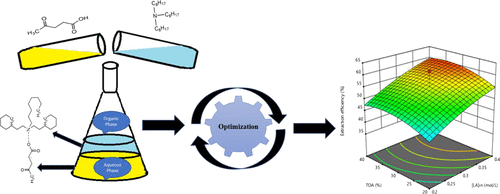当前位置:
X-MOL 学术
›
Ind. Eng. Chem. Res.
›
论文详情
Our official English website, www.x-mol.net, welcomes your
feedback! (Note: you will need to create a separate account there.)
Central Composite Design Approach for Optimization of Levulinic Acid Separation by Reactive Components
Industrial & Engineering Chemistry Research ( IF 3.8 ) Pub Date : 2021-09-14 , DOI: 10.1021/acs.iecr.1c02589 Anuj Kumar 1 , Diwakar Shende 1 , Kailas Wasewar 1
Industrial & Engineering Chemistry Research ( IF 3.8 ) Pub Date : 2021-09-14 , DOI: 10.1021/acs.iecr.1c02589 Anuj Kumar 1 , Diwakar Shende 1 , Kailas Wasewar 1
Affiliation

|
Separation of levulinic acid from the rejected stream and fermentation broth has become the topic of scientific interest or importance due to its variety of applications. In the present paper, the optimization study is carried out to find the maximum separation efficiency using various independent variables like the initial concentration of levulinic acid, concentration of trioctylamine extractant, temperature, and time. The response surface methodology in combination with central composite design (face-centered) was employed involving 30 experimental runs for the separation of levulinic acid. To understand the effect of independent variables on the separation efficiency and equilibrium constant, various experiments were performed. The optimum condition was observed at 0.5 mol·L–1 as the initial concentration of levulinic acid, 30% trioctylamine as the organic phase at a temperature of 27.5 °C for a shaking time of 4 h, which could lead to a separation efficiency 61.92%, and an equilibrium constant of 4.61 and is in close agreement with the predicted values of 62.23% and 4.61, respectively. The optimized conditions were applied, and three stages in series were designed to achieve 90% recovery of levulinic acid, which could reduce the energy requirement and waste generation and lead to an increase in the separation efficiency of levulinic acid. The obtained results can be used for the recovery of levulinic acid from the rejected stream and fermentation broth.
中文翻译:

反应组分优化乙酰丙酸分离的中心复合设计方法
由于其应用的多样性,从废弃的流和发酵液中分离乙酰丙酸已成为科学兴趣或重要性的主题。在本文中,使用各种自变量(如乙酰丙酸的初始浓度、三辛胺提取剂的浓度、温度和时间)进行优化研究以找到最大分离效率。采用响应面方法结合中心复合设计(面心),涉及 30 次实验运行以分离乙酰丙酸。为了了解自变量对分离效率和平衡常数的影响,进行了各种实验。最佳条件为 0.5 mol·L –1以乙酰丙酸的初始浓度、30%的三辛胺为有机相,在27.5℃下振荡4h,分离效率为61.92%,平衡常数为4.61,接近分别与 62.23% 和 4.61 的预测值一致。应用优化条件,设计三段串联,实现乙酰丙酸回收率90%,可降低能源需求和废物产生,提高乙酰丙酸的分离效率。所得结果可用于从废弃流和发酵液中回收乙酰丙酸。
更新日期:2021-09-22
中文翻译:

反应组分优化乙酰丙酸分离的中心复合设计方法
由于其应用的多样性,从废弃的流和发酵液中分离乙酰丙酸已成为科学兴趣或重要性的主题。在本文中,使用各种自变量(如乙酰丙酸的初始浓度、三辛胺提取剂的浓度、温度和时间)进行优化研究以找到最大分离效率。采用响应面方法结合中心复合设计(面心),涉及 30 次实验运行以分离乙酰丙酸。为了了解自变量对分离效率和平衡常数的影响,进行了各种实验。最佳条件为 0.5 mol·L –1以乙酰丙酸的初始浓度、30%的三辛胺为有机相,在27.5℃下振荡4h,分离效率为61.92%,平衡常数为4.61,接近分别与 62.23% 和 4.61 的预测值一致。应用优化条件,设计三段串联,实现乙酰丙酸回收率90%,可降低能源需求和废物产生,提高乙酰丙酸的分离效率。所得结果可用于从废弃流和发酵液中回收乙酰丙酸。









































 京公网安备 11010802027423号
京公网安备 11010802027423号